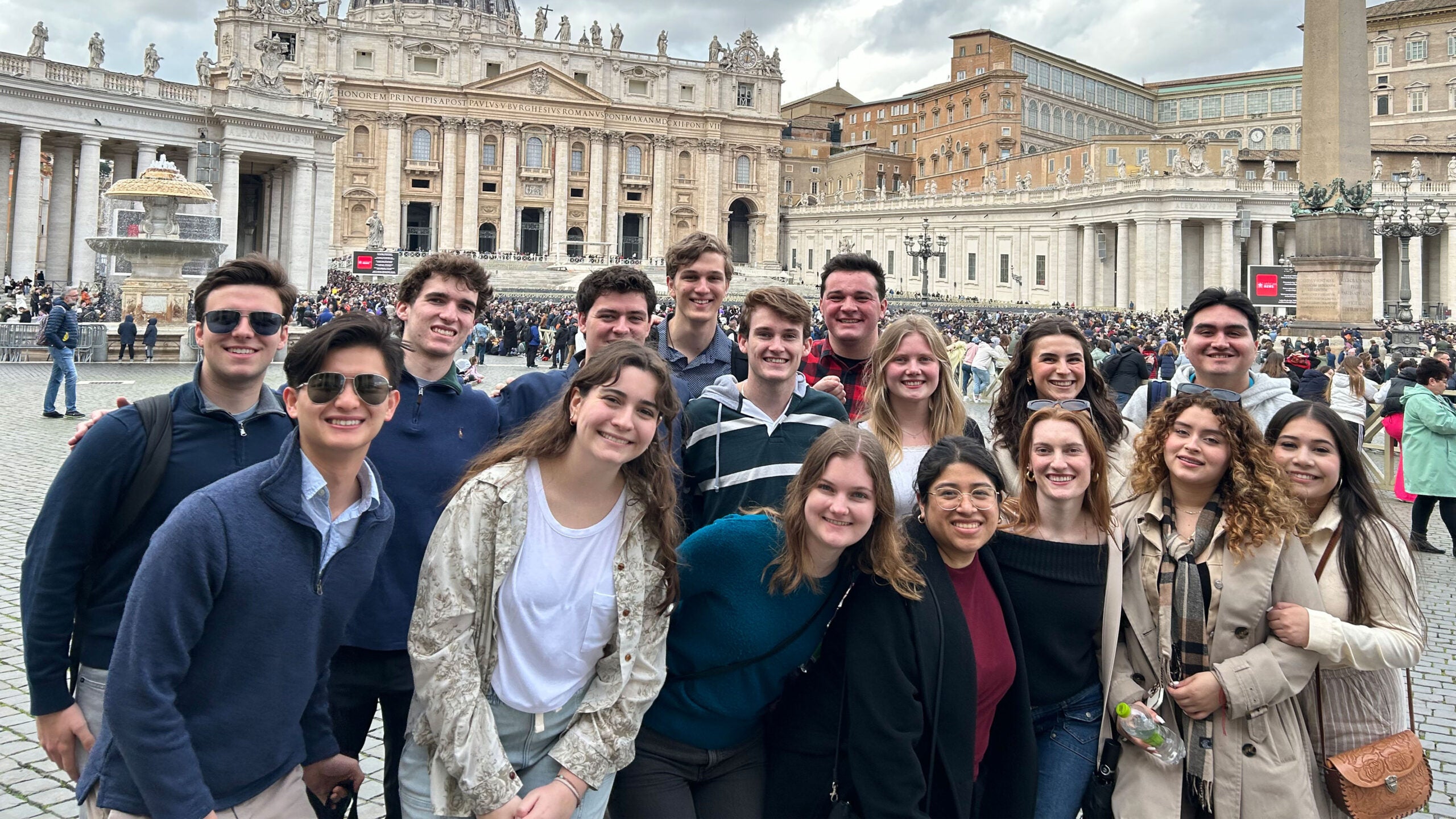Impactful Immersion: Georgetown’s Magis Trip to Rome
Theology of Pilgrimage
By Jennon Bell Hoffman
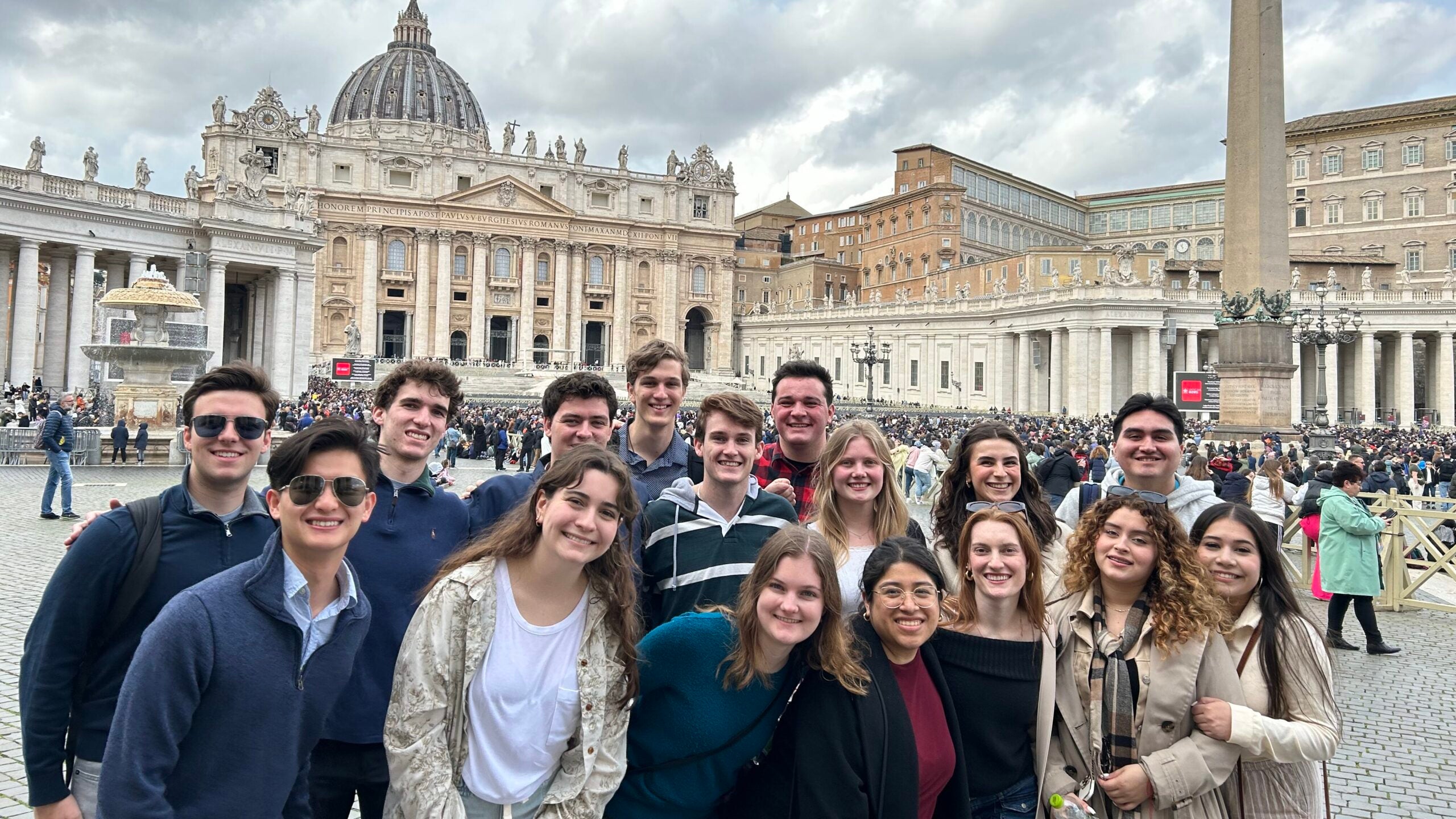
Hoyas in St. Peter’s Square, Vatican City.
Spring Break for college students can take on a lot of meanings. For students embarking on Magis Immersion Seminars (MIS), the emphasis is on personal growth, traveling together, and deepening their understanding during an on-the-ground experiential learning week. For John DiPierri (SFS’25), his time in Rome also helped him explore his own faith more deeply, resulting in an overflowing bucket-list of experiences.
The MIS course, titled “Theology of Pilgrimage: Rome” centered on investigating the theological, historical, sociological, and literary contours of pilgrimage, steeped in the Roman Catholic tradition but also incorporating other faith traditions. Led by Dr. Mark Bosco, S.J., the itinerary was jam-packed with visits to churches, tours of historical sites, personal audiences with both Jesuit scholars and local artists, Mass in the rooms of St. Ignatius, and a day trip to Assisi, Italy. For John, it was a whirlwind dream come true.
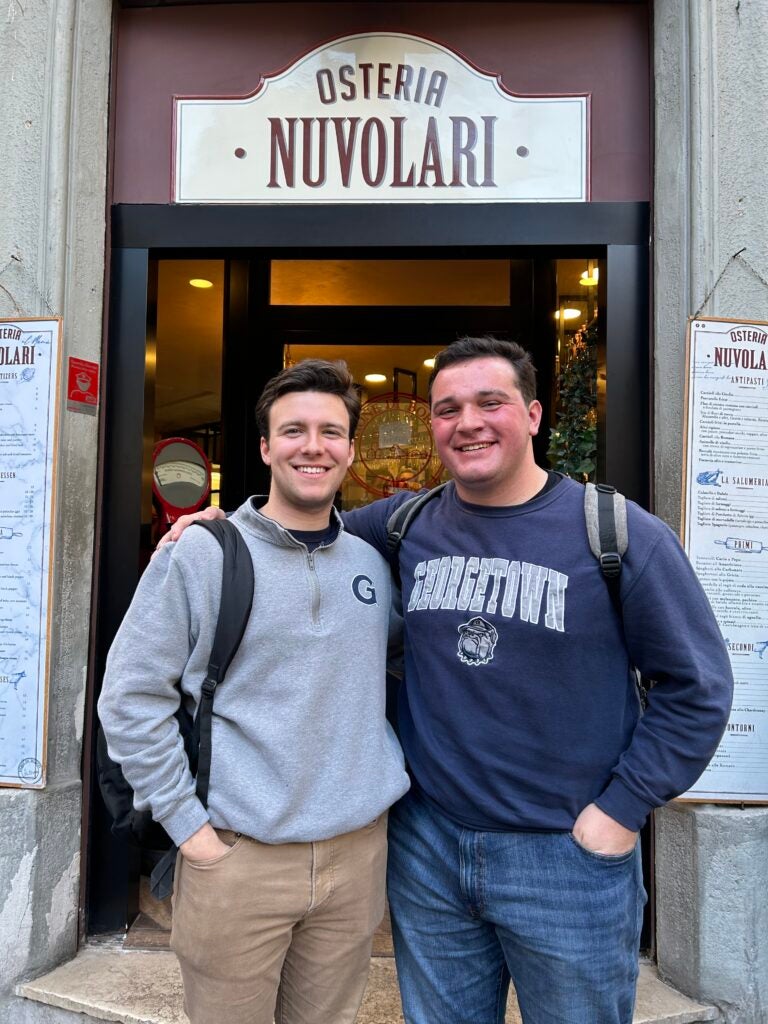
(left to right) John DiPierri (SFS’25) and Christopher LoPresti (C ’25).
“The course was structured by looking at Rome in layers: the early Christian Rome of Peter and Paul, and the early Christian leaders that were persecuted; visiting the Domus ecclesia, which were house churches where Christians worshiped during the time of persecution; moving on to the Church of Empire and the Middle Ages when the bishop of Rome asserted themselves politically and financially,” says John.
“Then we get into the Baroque period of the church and a lot of the buildings [we visited] showed this excessiveness, these beautiful ornate churches and these art movements so eloquently constructed. Every day we would go to four or five things for an onsite lecture and realize how important all of those places were…and still are.”
John estimates that they visited 30 to 40 churches over the course of their trip, often taking in the artwork and architecture before discussing the symbolism and narrative motifs that played a part in the faith practice of Roman Catholics.
“This trip really inspired me to engage very directly and passionately with my faith,” says John. “Seeing the tombs of martyrs and saints who have given their lives, and the hundreds of years that it took to build these beautiful churches and monasteries, and how they became part of Rome through their own unique stories…. it’s hard to deny that influence in your everyday life, that I’m a Catholic because of so many people before me, that nourish this faith, and the celebration of Christ in the Mass or in the buildings that they constructed.”
On a trip full of awe-inspiring and breathtaking moments, a few stuck out for their simplicity and grace in the moment.
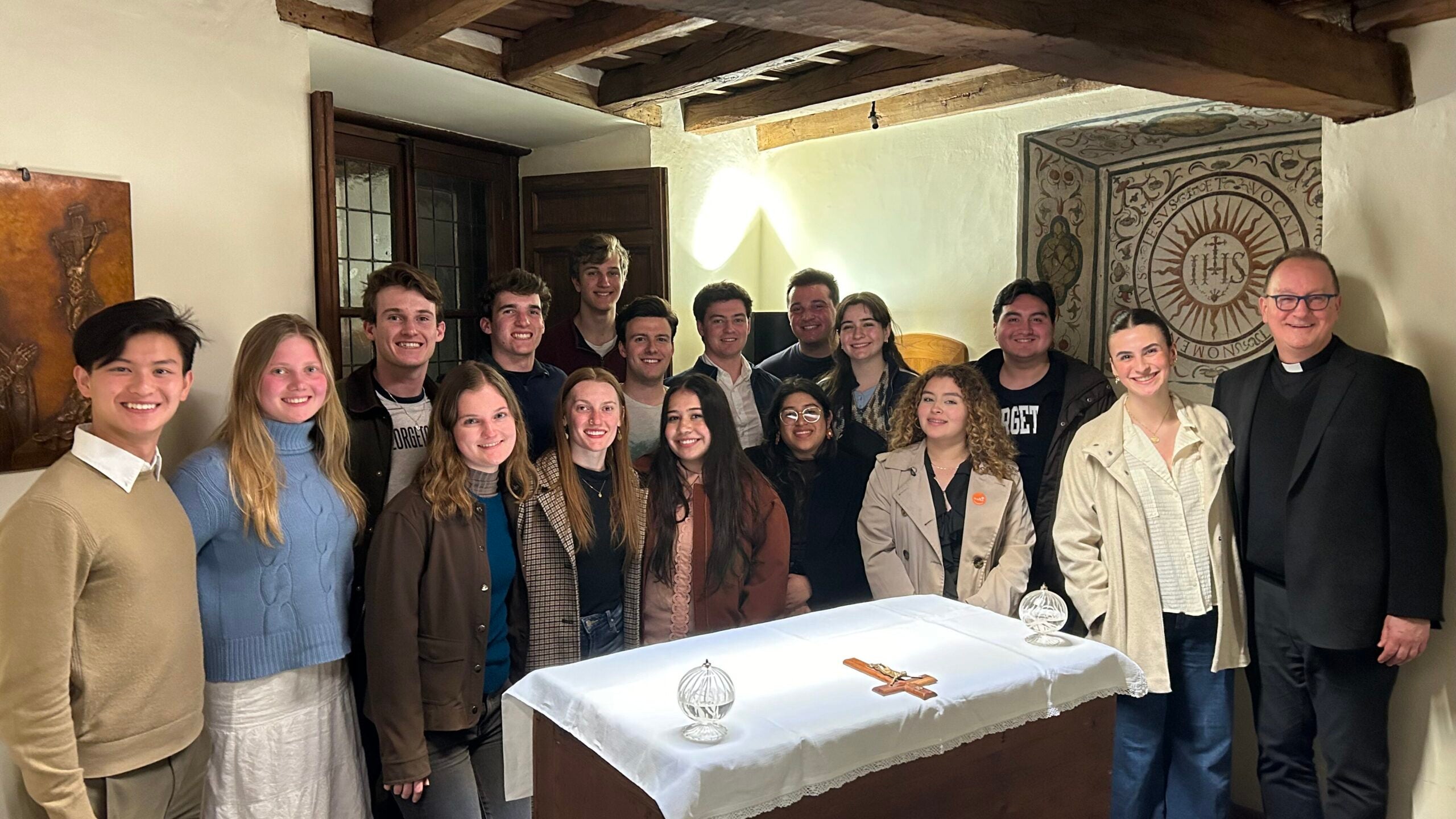
Hoyas with Dr. Mark Bosco, S.J. in Church of the Gesù.
“One of the most impactful moments we had was Mass at the Gesù, which is the Jesuit church, and we celebrated it in the Chapel of the Nobles, which is reserved only for the Italian aristocracy. But they let us celebrate Mass there and the co-concelebrant with Fr. Bosco had lived in that community for 10 years and still had never done Mass in that room. I did the Second Reading, so I felt very, very connected there,” recalls John.
The group also traveled to Assisi, two and a half hours north, to spend the day taking in the medieval town and environs of St. Francis of Assisi, whose devotion to the Lord and others served as a template for St. Ignatius’ piety. Being enmeshed in the historic and faith-filled surroundings once shared by St. Ignatius, Peter and Paul, saints, and other Catholic leaders and scholars left an indelible mark on John and his peers. Over the course of the trip, there were so many big, impactful moments, that the group started to call out their importance as “Top Five” moments.
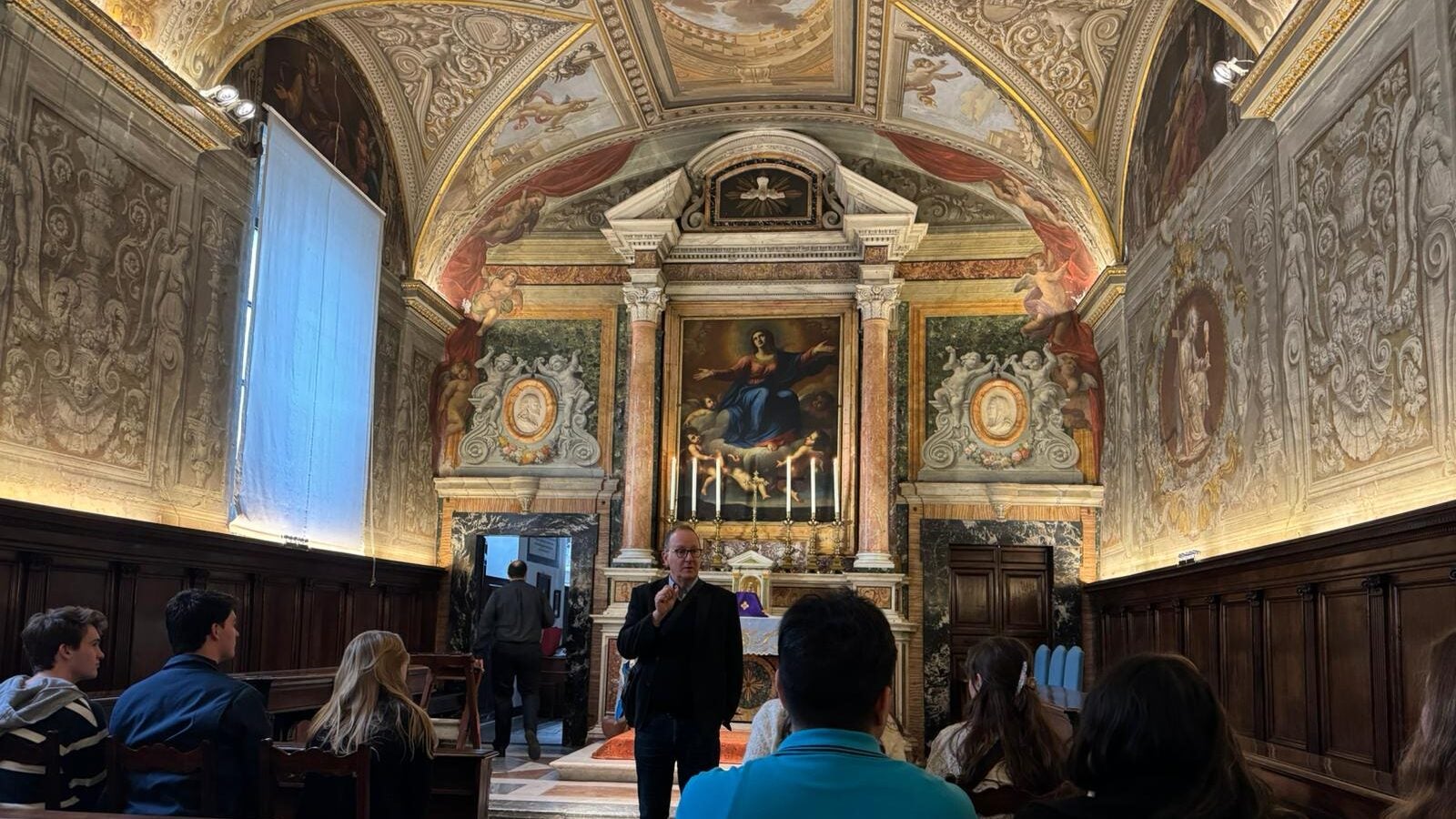
The Chapel of the Nobles, Dr. Mark Bosco, S.J., is explaining the chapel’s history.
“We were checking off bucket list items and also ‘faith bucket list’ items and we’d say to each other all the time, ‘Oh, this is a top five Catholic moment for us.’ What really made this trip so special for myself and my peers is that we were able to engage in the questions of our history and our faith and of the global world we live in,” says John. He has a list of top moments—well beyond five—because so many moments were so important and resonated for different reasons.
“Our second or third day we went to the Mamertine Prison where Peter and Paul both were awaiting their execution. We’re standing in the room just above their crypt and then through the window, there’s a rainbow that appears on the floor,” says John. “We all took a step back. I can’t even believe it… we didn’t even know where it was coming from [at first]. We were so taken aback, like, this is our faith right here.”
Though he is now back on the Hilltop and focused on finishing his junior year, John feels more enlivened than before about further examining his own faith and encouraging any prospective pilgrims to do the same.
“If you are Catholic, this is probably going to be one of your foremost experiences of your faith—to bear witness to the people and places that created your faith. And you engage with it deliberately, through the places you see and the stories you hear. And you also get to track the evolution of that church, from a ragtag group of disciples in the Holy Land to these two apostles in Rome, to the faith of almost 2 billion people today, and these beautiful, beautiful churches and public demonstrations of your faith.”
He adds, “I’m just very thankful to the alumni and the Office of Mission & Ministry for facilitating the class and the program as well. Because without them, certainly, we wouldn’t have had such a transformative experience.”
John DiPierri (SFS’25) is studying International Security and History.
Dr. Mark Bosco, S.J., is the vice president for Mission & Ministry at Georgetown University. He teaches in the English and Theology departments. Photos courtesy of Dr. Mark Bosco, S.J.
Jennon Bell Hoffmann is a freelance writer and editor living in Chicago.
- Tagged
- Bosco
- Magis
- Pilgrimage
- Rome
